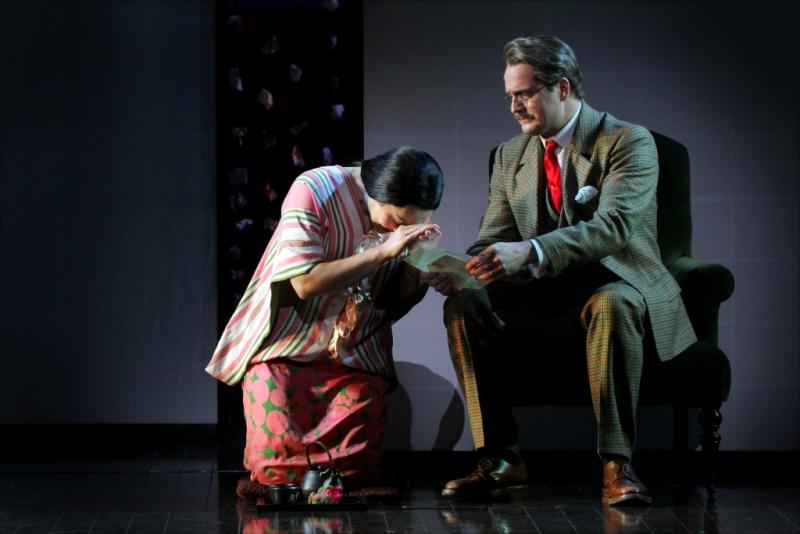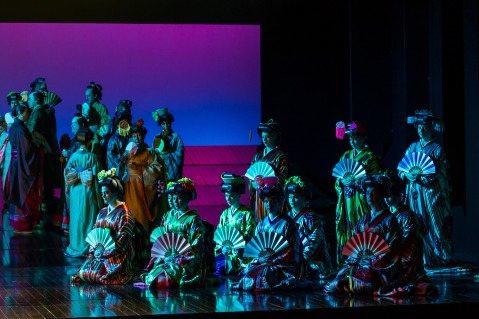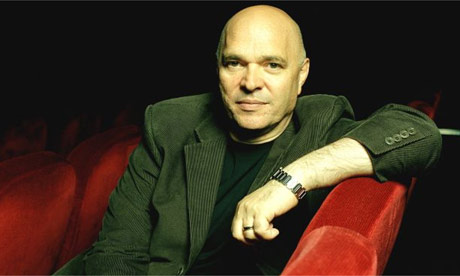Madam Butterfly, English National Opera | reviews, news & interviews
Madam Butterfly, English National Opera
Madam Butterfly, English National Opera
The late Anthony Minghella's ice-cool staging of Puccini's ardent masterpiece returns to ENO

When the going gets tough, wheel out a crowd-pleaser. Even by its own volatile standards English National Opera has had a poor start to its autumn season, with productions of Fidelio and Die Fledermaus that seem destined to join the company’s ever-growing chamber of unrevivable horrors. ENO’s cash-strapped board must therefore be lighting another candle to the late Anthony Minghella, whose glacially delicate Madam Butterfly is always good for an outing.
It’s an award-winning favourite that was mounted with extraordinary sensitivity by a director better known for his film work. Cards on the table: it’s a staging I find infuriating, yet despite myself I relished the chance to wallow again in its gorgeousness. If you haven’t seen it before, don’t let me put you off. A feast for the eye is guaranteed.
The story of Cio-Cio San is a heartbreaking tale of devotion, rejection and despair
The visual language is a paean to the ritualised beauty of traditional Japanese art – a decision that would be ideal were it not for the contradictory mood of Puccini’s score, which drips with Italian fervour. The story of Cio-Cio San, a young geisha whose night of pleasure with US Naval Lieutenant Pinkerton means so much more to her than it does to him, is a heartbreaking tale of devotion, rejection and despair. Inevitably, though, in directing this latest revival Sarah Tipple has stayed faithful to Minghella’s blueprint – which means that scenes like the erotic Act One love duet still flounder. Although ravishing to behold with its sea of hand-held lanterns and scattered rose petals, the tenor of idealised love versus rampant sexuality is completely neutralised by a wash of ostentatious, Kabuki-scented prettiness.
The Italian conductor Gianluca Marcianò made a distinguished house début, shaping Puccini’s rich, cod-exotic orchestrations with exemplary balance and securing ensemble work from the ENO Chorus and Orchestra that was at once precise and relaxed. He was wholly attentive to the needs of his solo singers; it was certainly not his fault that Timothy Richards’s smallish voice failed to cut past the footlights and caused his Pinkerton to make such a disappointingly pale impression.
With far richer vocal colours and a heartbreaking engagement with her character, the Russian-American soprano Dina Kuznetsova was a revelation as Cio-Cio San. Her full-blooded timbre, darker of hue than we usually hear in this girlish role, lent a mournful flavour to her performance and made for an exceptional partnership with mezzo Pamela Helen Stephen’s wonderfully sung, fully-realised Suzuki. The silent collapse of Stephen’s face on learning the truth about Pinkerton was reactive acting of the highest order.

Cio-Cio San's wedding guests in Act One of ENO's Madam Butterfly
It is always a pleasure to see baritone George von Bergen’s name on a roster: he is a very fine operatic actor. His bumbling Sharpless, the bluff but baffled American Consul, was a characteristically well-delineated creation that more than made up for an atypically unfocused vocal performance. Only an off-night I hope. There were strong cameos from Alun Rhys-Jenkins as the marriage-broker Goro, Mark Richardson as the intimidating Bonze, Alexander Robin Baker as Prince Yamadori (Butterfly’s would-be suitor) and, especially, from a clear-voiced Catherine Young as poor Kate Pinkerton.
The fifth principal in Madam Butterfly is Sorrow, Cio-Cio San’s son – a challenging part for a young child to carry off successfully, albeit one that was managed with moving aplomb by a very small boy at Opera Holland Park earlier this year. In 2005, when this ENO production first appeared, Minghella (pictured below) famously rejected the human option in favour of the fabulous puppetry of Blind Summit – and four revivals in it still doesn’t work.
 The problem is simple and should have been obvious to such a gifted director: however ingenious the manipulation by three skilled Bunraku puppeteers, it only serves to draw the audience away from an emotional connection with Pinkerton's innocent offspring and into a mood of detached admiration for the sheer cleverness of it all. The portrayal has a certain wooden charm but it is no substitute for a flesh-and-blood child whose vulnerability might awaken the spectator’s protective instincts. To watch human hands bring a telescope to a puppet’s eye is distracting, not affecting.
The problem is simple and should have been obvious to such a gifted director: however ingenious the manipulation by three skilled Bunraku puppeteers, it only serves to draw the audience away from an emotional connection with Pinkerton's innocent offspring and into a mood of detached admiration for the sheer cleverness of it all. The portrayal has a certain wooden charm but it is no substitute for a flesh-and-blood child whose vulnerability might awaken the spectator’s protective instincts. To watch human hands bring a telescope to a puppet’s eye is distracting, not affecting.
The real hero of Minghella’s Madam Butterfly is Peter Mumford, who is responsible for the ingenious lighting. It is impossible to overstate Mumford’s role in defining the production: his work breathes life into Michael Levine’s opulently spare designs and transforms an almost bare, almost flat rectangular stage into an epic world. The penumbral lighting of motionless singers in Act One (see top of page) turned them for one extraordinary moment into an array of icons, the variegated satin of their costumes made to resemble the painted models of Cio-Cio San’s ancestors. It was just one dazzling effect in a production that is bathed in beauty from first to last. If only it were more than skin-deep.
rating
Explore topics
Share this article
Add comment
The future of Arts Journalism
You can stop theartsdesk.com closing!
We urgently need financing to survive. Our fundraising drive has thus far raised £49,000 but we need to reach £100,000 or we will be forced to close. Please contribute here: https://gofund.me/c3f6033d
And if you can forward this information to anyone who might assist, we’d be grateful.

Subscribe to theartsdesk.com
Thank you for continuing to read our work on theartsdesk.com. For unlimited access to every article in its entirety, including our archive of more than 15,000 pieces, we're asking for £5 per month or £40 per year. We feel it's a very good deal, and hope you do too.
To take a subscription now simply click here.
And if you're looking for that extra gift for a friend or family member, why not treat them to a theartsdesk.com gift subscription?
more Opera
 La bohème, Opera North review - still young at 32
Love and separation, ecstasy and heartbreak, in masterfully updated Puccini
La bohème, Opera North review - still young at 32
Love and separation, ecstasy and heartbreak, in masterfully updated Puccini
 Albert Herring, English National Opera review - a great comedy with depths fully realised
Britten’s delight was never made for the Coliseum, but it works on its first outing there
Albert Herring, English National Opera review - a great comedy with depths fully realised
Britten’s delight was never made for the Coliseum, but it works on its first outing there
 Carmen, English National Opera review - not quite dangerous
Hopes for Niamh O’Sullivan only partly fulfilled, though much good singing throughout
Carmen, English National Opera review - not quite dangerous
Hopes for Niamh O’Sullivan only partly fulfilled, though much good singing throughout
 Giustino, Linbury Theatre review - a stylish account of a slight opera
Gods, mortals and monsters do battle in Handel's charming drama
Giustino, Linbury Theatre review - a stylish account of a slight opera
Gods, mortals and monsters do battle in Handel's charming drama
 Susanna, Opera North review - hybrid staging of a Handel oratorio
Dance and signing complement outstanding singing in a story of virtue rewarded
Susanna, Opera North review - hybrid staging of a Handel oratorio
Dance and signing complement outstanding singing in a story of virtue rewarded
 Ariodante, Opéra Garnier, Paris review - a blast of Baroque beauty
A near-perfect night at the opera
Ariodante, Opéra Garnier, Paris review - a blast of Baroque beauty
A near-perfect night at the opera
 Cinderella/La Cenerentola, English National Opera review - the truth behind the tinsel
Appealing performances cut through hyperactive stagecraft
Cinderella/La Cenerentola, English National Opera review - the truth behind the tinsel
Appealing performances cut through hyperactive stagecraft
 Tosca, Royal Opera review - Ailyn Pérez steps in as the most vivid of divas
Jakub Hrůša’s multicoloured Puccini last night found a soprano to match
Tosca, Royal Opera review - Ailyn Pérez steps in as the most vivid of divas
Jakub Hrůša’s multicoloured Puccini last night found a soprano to match
 Tosca, Welsh National Opera review - a great company reduced to brilliance
The old warhorse made special by the basics
Tosca, Welsh National Opera review - a great company reduced to brilliance
The old warhorse made special by the basics
 BBC Proms: The Marriage of Figaro, Glyndebourne Festival review - merriment and menace
Strong Proms transfer for a robust and affecting show
BBC Proms: The Marriage of Figaro, Glyndebourne Festival review - merriment and menace
Strong Proms transfer for a robust and affecting show
 BBC Proms: Suor Angelica, LSO, Pappano review - earthly passion, heavenly grief
A Sister to remember blesses Puccini's convent tragedy
BBC Proms: Suor Angelica, LSO, Pappano review - earthly passion, heavenly grief
A Sister to remember blesses Puccini's convent tragedy
 Orpheus and Eurydice, Opera Queensland/SCO, Edinburgh International Festival 2025 review - dazzling, but distracting
Eye-popping acrobatics don’t always assist in Gluck’s quest for operatic truth
Orpheus and Eurydice, Opera Queensland/SCO, Edinburgh International Festival 2025 review - dazzling, but distracting
Eye-popping acrobatics don’t always assist in Gluck’s quest for operatic truth

Comments
What set me in a rage the one
Yes David, it's still there -